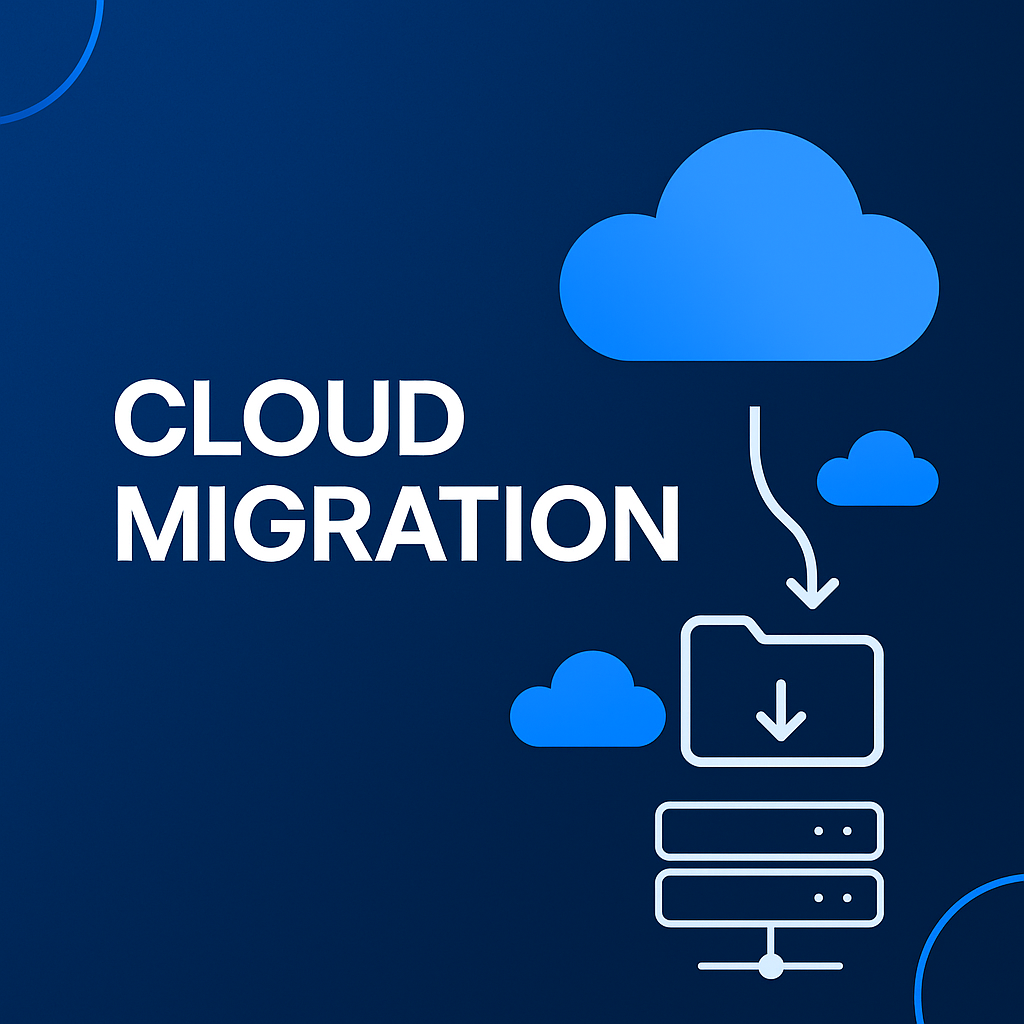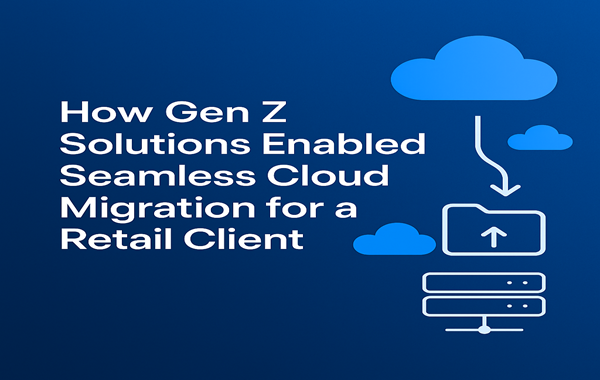Case Study: How Gen Z Solutions Enabled Seamless Cloud Migration for a Retail Client
Introduction:
As businesses continue to grow and expand, the need for scalability and flexibility in their operations becomes increasingly critical. The cloud offers a significant advantage by providing businesses with the ability to scale their infrastructure on-demand, ensure data availability, and access powerful tools that drive innovation and efficiency. Determining the right time for cloud migration is crucial for businesses looking to stay competitive in today's digital landscape.
Gen Z Solutions, a forward-thinking IT solutions provider, specializes in helping businesses transition to the cloud. As one of the leading cloud migration companies, they offer comprehensive cloud migration services to ensure a smooth transition. In this case study, we will explore how Gen Z Solutions implemented an effective cloud migration strategy to help a retail client seamlessly migrate to the cloud, optimizing operations, and delivering tangible results that helped the client stay competitive in an ever-evolving digital landscape.
Challenges Before Migration:
-
Infrastructure Limitations: The client's on-premise infrastructure was struggling to support their growing business needs. The existing IT infrastructure was unable to handle the increasing volume of transactions and data, leading to frequent system downtimes and performance issues. This highlighted the need for robust cloud infrastructure management.
-
Scalability Concerns: As the business grew, their on-premise servers were becoming increasingly insufficient. The client needed a solution that could easily scale to accommodate future growth without requiring a significant upfront investment in hardware. Scalability was a key factor in considering cloud migration.
-
Data Security: Managing data security was becoming more complex. The client was concerned about the security and compliance of their data, especially with the increasing regulatory requirements around data protection and privacy. They needed a solution that could provide robust security measures and ensure compliance with industry standards.
-
Cost Inefficiencies: Maintaining the on-premise infrastructure was expensive. The client was incurring high operational costs related to hardware maintenance, power consumption, and IT staff to manage the servers. Additionally, the infrastructure was underutilized, leading to inefficiencies in cost management.
-
Lack of Integration with New Technologies: The client was also facing difficulties integrating new technologies such as artificial intelligence (AI), machine learning (ML), and data analytics, which could have enhanced their business processes and decision-making. They needed a flexible platform that could support these advanced technologies.
Before the cloud migration, the retail client faced several challenges that impacted their operations and growth potential:
The Solution: Cloud Migration with Gen Z Solutions
Gen Z Solutions took a comprehensive approach to help the client transition to the cloud by following a structured and well-planned cloud migration strategy. The main objective was to ensure that the migration was seamless, cost-effective, and aligned with the client's business goals. The team employed various cloud migration services to address the client's specific needs.
-
Initial Assessment and Planning: The first step in the cloud migration strategy was to conduct a thorough assessment of the client's existing infrastructure, applications, and business needs. Gen Z Solutions worked closely with the client to understand their objectives, pain points, and future growth plans. This cloud readiness assessment was crucial in developing an effective cloud migration roadmap.
-
Selecting the Right Cloud Platform: Based on the client's needs and objectives, Gen Z Solutions recommended a cloud platform that offered the best scalability, flexibility, and security. The team evaluated several cloud providers and selected one that matched the client's requirements for speed, uptime, and cost-effectiveness.
-
Seamless Data Migration: One of the most critical steps in the cloud migration strategy was ensuring the seamless transfer of data from the client's on-premise systems to the cloud. Gen Z Solutions implemented structured data migration services, minimizing downtime and ensuring the integrity of the data during the transition.
-
Application Re-Platforming: To maximize the potential of the cloud, certain legacy applications had to be re-platformed for compatibility with the new cloud infrastructure. Gen Z Solutions performed a comprehensive assessment of the client's applications to determine which ones needed to be re-architected for the cloud.
-
Optimization and Performance Tuning: After the migration was complete, the Gen Z Solutions team conducted a series of optimizations and performance tuning to ensure the cloud infrastructure was running at peak efficiency. This included adjusting resource allocation, monitoring system performance, and implementing automated scaling to handle peak traffic times.
-
Security and Compliance: Data security and compliance were top priorities throughout the cloud migration process. Gen Z Solutions implemented robust security measures, including end-to-end encryption, multi-factor authentication, and regular vulnerability assessments, to safeguard the client's data.
-
Training and Support: To ensure the successful adoption of the new cloud environment, Gen Z Solutions provided comprehensive training to the client's staff. The team conducted hands-on training sessions to familiarize the client's team with the new cloud tools and technologies.
After assessing the current environment, Gen Z Solutions identified the most appropriate cloud solution for the client, ensuring it aligned with their business needs and long-term strategy. The team also conducted a detailed risk assessment and outlined a roadmap for the entire migration process, including potential cloud migration challenges and cloud migration risks.
The chosen cloud platform was selected for its ability to integrate with various enterprise tools, as well as its robust security features to ensure the client's data remained safe during and after migration. The solution also considered the possibility of implementing a hybrid cloud or multi-cloud approach to maximize flexibility and minimize vendor lock-in.
The team used advanced cloud migration tools to transfer large datasets while ensuring that there were no interruptions to the client's business operations. Data validation and verification were carried out to ensure that the information was correctly transferred and was in sync with the new cloud environment.
The team worked closely with the client to ensure minimal disruption to their daily operations while modernizing the applications. This process of moving applications to cloud involved a combination of replatforming and refactoring techniques. By re-platforming critical applications, the client was able to leverage the benefits of cloud-based tools and technologies, such as AI and machine learning, that would have been difficult to integrate into the old on-premise infrastructure.
Performance optimization efforts led to faster application response times, improved system stability, and better resource utilization, which helped the client deliver more efficient and responsive services to their customers. This focus on cloud performance was crucial in realizing the full benefits of the migration.
The team also ensured that the client's cloud infrastructure adhered to relevant industry standards and compliance regulations, including data protection laws and privacy requirements. This ensured that the client's sensitive data remained secure and that they could meet their regulatory obligations with ease. Additionally, the new cloud environment included enhanced disaster recovery capabilities, providing better business continuity.
Ongoing support and maintenance were also offered post-migration to address any issues or questions the client might have. This included 24/7 support and troubleshooting to ensure smooth operation and to resolve any challenges that arose after the migration. The support team was well-versed in multi-cloud environments, allowing them to assist with any complexities arising from the client's cloud setup.

The Benefits:
The successful implementation of the cloud migration strategy brought a host of benefits to the client, both in terms of operational efficiency and cost-effectiveness:
-
Scalability: The cloud environment allowed the client to easily scale their infrastructure to meet growing demand. As their business expanded, they could quickly allocate additional resources to handle traffic spikes without any manual intervention. This improved scalability was a key advantage of the cloud migration.
-
Cost Savings: By moving to the cloud, the client was able to reduce the high costs associated with maintaining on-premise hardware and IT staff. The pay-as-you-go cloud model also allowed the client to better manage their IT expenses, paying only for the resources they used. These cost savings were a significant cloud migration benefit.
-
Improved Performance: The cloud infrastructure provided better performance, with faster load times and improved reliability. The client's applications were more responsive, which enhanced the user experience and helped retain customers. The focus on cloud performance during the migration process paid off in tangible improvements.
-
Increased Agility: The cloud migration provided the client with greater flexibility and agility. They could quickly adapt to changing business needs and incorporate new technologies, such as AI and data analytics, into their processes. The multi-cloud approach allowed them to leverage the best services from different cloud providers.
-
Enhanced Security: The cloud provider's robust security features gave the client peace of mind that their data was protected. Regular security updates and compliance checks ensured that their cloud infrastructure met industry standards. The improved disaster recovery capabilities also enhanced the overall security posture of the client's IT infrastructure.
Conclusion:
Gen Z Solutions successfully helped the client transition to the cloud, delivering a seamless migration experience while addressing the challenges posed by the previous on-premise infrastructure. The comprehensive cloud migration strategy enabled the client to scale their operations, reduce costs, and improve performance. With the cloud now fully integrated into their operations, the client is well-positioned to leverage the latest technologies to drive future growth and innovation.
By partnering with Gen Z Solutions, one of the leading cloud migration companies, the client was able to harness the full potential of cloud computing, enabling them to stay competitive in a rapidly evolving market. This case study highlights the importance of choosing the right cloud migration services provider and the transformative impact of cloud adoption for businesses of all sizes. It demonstrates that with the right cloud migration strategy and expert guidance, businesses can overcome cloud migration challenges and realize significant cloud migration benefits.


